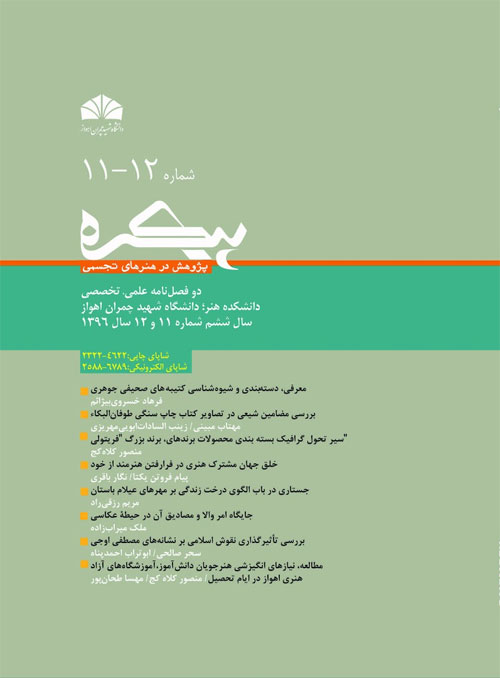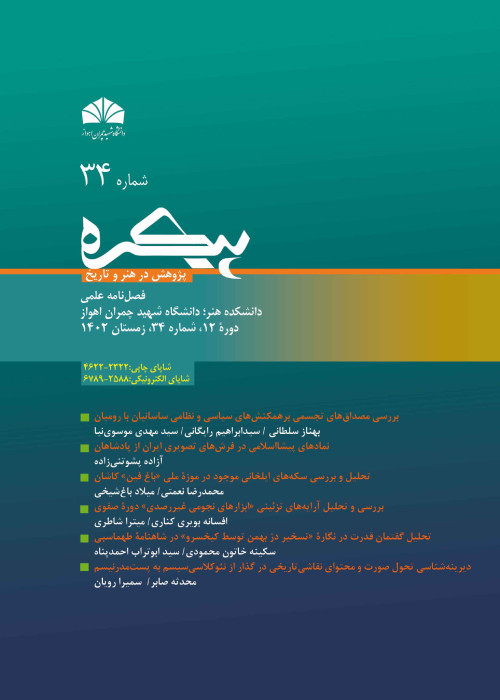فهرست مطالب

نشریه پیکره
پیاپی 12 (پاییز و زمستان 1396)
- تاریخ انتشار: 1396/10/12
- تعداد عناوین: 4
- مقاله پژوهشی
-
صفحات 63-87تحول فرم های مختلفی از درخت زندگی در دوران پیشاتاریخ و تاریخی، به ویژه در فرهنگ های شرقی، به برکت بهره گیری از مفاهیم مشترکی چون جوانه زدن، شاخه گستردن در آسمان و ریشه دواندن در خاک به عنوان نمادی از زندگی، اندیشه و کمال شناخته شده است. از این رو پژوهش پیش رو درصدد است تا با عنایت به این موضوع، پس از بررسی مختصر نقش و جایگاه درخت در فرهنگ ها، با مطالعه دیداری الگوی درخت زندگی بر مهرهای عیلام باستان، به تبیین و شناخت رمزواره ها و مفاهیم موجود در این نقش مایه و نمادهای مرتبط بپردازد. از معیارهای اولیه انتخاب موضوع درخت زندگی در پژوهش حاضر، استمرار و فراوانی کاربرد این نقش بر مهرهای عیلام و اهمیت نقش آن در طول تاریخ است. این پژوهش به لحاظ هدف، بنیادی، روش ارایه آن، توصیفی و تحلیلی است. گردآوری اطلاعات آن بر مبنای کتابخانه ای و دیجیتال است. یافته های به دست آمده این پژوهش نشان می دهد که درخت زندگی در عیلام دارای جوهر الهی بوده و بر اساس باور داشت های بنیادین و نظام باورهای جامعه به نمادی اعتقادی بدل گشته و صورت مثالی درخت به عنوان مهم ترین منبع زایش و باروری در تمدن عیلام شمرده می شدکلیدواژگان: درخت زندگی، مهرهای عیلام باستان، زایش و باروری، خدایان عیلامی
-
صفحات 89-106احساس والا، همان احساس برتر ناشناخته ای است که دست یابی به آن نقش ارزنده ای در انسان سازی دارد و انسان را بیش از پیش با یقین حقیقی اش آشنا می نماید. این احساس توام با پرورش ایده های اخلاقی نیرومندتر و قوی تر تحقق می یابد و رابطه ای مستقیم با هویت اصیل انسانی برقرار می سازد و حتی برای لحظاتی وی را وادار می کند، به فکر فرو رفته و در انسان بودن خویش تامل نماید. امر والا، اندیشه ای است که از اواخر سده هفدهم، آغاز شد. "ادموندبرک "، "ایمانوئل کانت " و در عصر جدید "ژان فرانسوا لیوتار "، از جمله مهم ترین فلاسفه و نظریه پردازانی بودند که به این اندیشه در حوزه زیبایی شناسی پرداختند. این اندیشه بر تمام چیزهایی که تجارب هیبت انگیز را برای آدمی فراهم می آورد، مبتنی می باشد، از جمله اقیانوس بی کران، پرتگاهی عمیق و غیره. حتی لفظی با شکوه مثلا در شعر حماسی یا عملی انسانی و اندیشه ای متعالی و نادر که قابل ستایش و تحسین باشد و شگفتی آدمی را برانگیزد نیز در حوزه این اندیشه گنجانده می شود. امر والا، نه فقط در حوزه زیبایی شناسی، بلکه در خاستگاه آثار هنرمندان جایگاه خود را پیدا کرد، لذا در هنر عکاسی، عکاسان نیز به دنبال ایجاد احساس والا در سطح دو بعدی عکس بودند. این تحقیق توصیف امر والا از نظر تاریخی و هنری و تطبیق دیدگاه و نظریات فلاسفه با مفاهیم عکاسی و نیز شناخت، به احساس و اندیشه عکاسان برای خلق عکس هایی است که بیینده را فراتر از تصور درگیر خود می کند. روش تحقیق توصیفی و تحلیلی است و منابع آن کتابخانه ای است.کلیدواژگان: امروالا، مصادیق عکاسی، واقعیت، فراواقعیت
-
صفحات 109-123مرور اجمالی آثار گرافیک ایران نشان می دهد که، بهره گیری مستقیم و غیرمستقیم از نقش ها، نمادها، عناصر و تصاویر دوره های مختلف تاریخی در این آثار وجود داشته و طراحان ایرانی به ضرورت موضوع سفارش، همواره این عناصر را دستمایه طراحی خود قرار داده اند. وجود جنبه های تزیینی و نیز قابلیت های بصری نقش های اسلامی موجب تاثیر این نقوش بر آثار طراحان گرافیک ایران شده است. نمونه های این تاثیرگذاری بر آثار طراحان گرافیک ایران فراوان است. مصطفی اوجی از طراحان معاصر گرافیک ایران است که این تاثیر پذیری در کارهایش دیده شده است. در این تحقیق با هدف شناخت کیفیت تاثیرگذاری نقوش اسلامی بر آثار مصطفی اوجی، نشانه های وی به شیوه توصیفی و تحلیلی بررسی می شوند. منابع این تحقیق، منابع کتابخانه ای و برخی از نشانه های مصطفی اوجی هستند. اینکه چرا و چگونه این نقوش بر نشانه های مصطفی اوجی تاثیر گذاشته، سوالاتی است که در این تحقیق به آن ها پاسخ داده می شودکلیدواژگان: نشانه، نقوش، هنر اسلامی، مصطفی اوجی
-
صفحات 125-133آموزش هنر در مدارس که به طور عمده متمرکز بر هنرهای تجسمی، چون طراحی ، نقاشی وخوشنویسی است، علی رغم این که سابقه ای طولانی دارد، اما به دلایل مختلف تاکنون چندان جدی گرفته نشده و در مواردی دیده شده که دانش آموزان در ایام تحصیل علائق هنری خود را در رشته های تجسمی نام برده در خارج از مدرسه پی گیری می کنند. با توجه به این مسئله، این پژوهش در نظر دارد، به سه سوال بنیادی، چرائی عدم اتکاء دانش آموزان به آموزش رشته های هنری در مدارس و دلیل پی گیری آموزش آن در آموزشگاهای آزاد نسبت به مدارس و نیز هدف کلی دانش آموزان ازفراگیری دروس هنری در خارج از مدارس، پاسخ دهد. نمونه جامعه مورد مطالعه هنرجویان چند آموزشگاه آزاد اهواز است. فرض این است علت گرایش دانش آموزان به آموزش هنر در آموزشگاهای آزاد، نشات گرفته از پی گیری یک تخصص هنری به صورت حرفه ای در آینده است. هدف این پژوهش، شناخت مهم ترین انگیزه دانش آموزان برای یادگیری مهارت های هنری در آموزشگا های آزاد هنری در طول سال تحصیلی است. روش این تحقیق پیمایشی است که با محور قرار دادن سه پرسش بنیادی اشاره شده و طرح سوالاتی مرتبط با سه پرسش مطرح شده، براساس طیف لیکرت، نتیجه را ارائه می کند. یافته های این مقاله نشان می دهد، علت استقبال دانش آموزان از آموزش هنر فراتر از مدرسه و به طور خاص در آموزشگاهای آزاد، نشات گرفته از علاقه آن ها به حرفه ای شدن در رشته ای خاص در آینده است.کلیدواژگان: آموزش، هنر، آموزشگاه، مدارس، دانش آموز، اهواز
-
Pages 63-87The evolution of various forms of life tree in history and prehistory, particularly in oriental cultures, has been recognized as a symbol of life, thought and perfection thanks to commonly understood concepts such as seed germination, extension of the tree branches in the sky and penetration of the roots in the ground. The present research aims to identify and explain the symbols represented in the motifs shown on the seals of ancient Elam. To this end, first the role and place of trees in different cultures was briefly explained. Basically, the issue of life tree was selected mainly due to its frequency of usage in the seals of Elam. Data were mainly gathered based on library sources and reliable websites and were then analyzed descriptively. The results indicated that the life tree on the Elam seals is a motif implying a divine concept turning, in the course of time, to a religious belief. The tree-like form alludes to the idea of productivity and fertility in Elam civilization.Keywords: life tree, seals of ancient Elam, productivity, fertility, Elam gods
-
Pages 89-106The Supreme Sense is the same superior arcane feeling through which the actual quality of being a human is formed and accordingly a human being will be able to appreciate the true essence of his/her existence. Realized through raising moralities, such a sense makes an association with the true identity (self) of a person impelling him/her to reflect, even for moments, on the genuine meaning of being a human. The idea of the Sublime was originally suggested in the late of the 17th century. Edmund Burke, Immanuel Kant and in the contemporary era, Jean-François Lyotard, are among the most influential philosophers and theoreticians addressing the idea of the Sublime particularly in aesthetics. This idea dominates all other awe-inspiring experiences like seeing an endless ocean or standing on the edge of a precipice. Even a significant word, in an epic for example, or a transcendental thought realized by a human being deserving admiration is also included in the scope of the Sublime. Not only in the realm of aesthetics, but also in the artists’ works, the Sublime has been represented. Similarly, photographers, too, have tried to convey the Supreme Sense to their viewers by means of a two-dimensional medium: orography. The present article examines the idea of the Sublime historically and aesthetically and studies the ideas of the philosophers comparatively addressing the issue of photography. In fact, the thoughts and feelings of the photographers to create photos engaging the viewers well beyond the phots themselves, have been addressed. Data were collected based on library sources and analyzed descriptively.Keywords: Supreme Thing, instances, photography, reality, Hyperreality
-
Pages 109-123A review of the Iranian graphic works indicates that the impressions of the signs, symbols, elements and images of the different historical eras in Iran have been represented, directly or indirectly, in these works. In fact, Iranian graphic designers have always taken advantage of the mentioned visual elements in their works depending on the theme under consideration. Since the Islamic motifs are rich in terms of decorative aspects and visual potentials, nearly all works of the Iranian graphic designers have been influenced by them. In fact, numerous cases of such impressions can be shown. In this respect, Mostafa Oji is among the contemporary Iranian graphic designers whose works have been strongly influenced or inspired by Islamic motifs. In this research, aiming to study the extent to which the works of Oji have been under the influence of the Islamic motifs, his signs have been analyzed descriptively. Data were gathered based on library sources and on certain signs of Oji. The way, and to what extent, the Islamic motifs have influenced Oji’s works, have been addressed in this research.Keywords: sign, Islamic motifs, Mostafa Oji
-
Pages 125-133Although art teaching at schools in Iran, focusing mainly on visual arts like drawing, painting and sculpture, has a long history, it seems that it has not been taken seriously for different reasons. Often is it the case that students follow their interests in art outside the formal academic schools. In this regard, the present study aimed to answer three key questions: Why do not students rely on art teaching at formal academic schools? Why do they prefer to learn art at privately-organized art teaching centers? What is the main motivation for the students to follow art at privately-organized art teaching centers? The respondents included students at several privately-organized art teaching centers in Ahvaz, Iran. It was hypothesized that students are motivated to learn art at such art teaching centers to follow an art expertise in future professionally. This research intended to identify the motivation of the students to learn art at above-mentioned centers. The researchers surveyed the students’ responses to the mentioned questions posed using Likert Scale. The results indicated that students prefer to follow art at such centers, beside their formal teachings or as an independent alternative, mainly because they want to become a professional artist in a specific branch.Keywords: art, teaching, art teaching center, visual arts, Ahvaz


